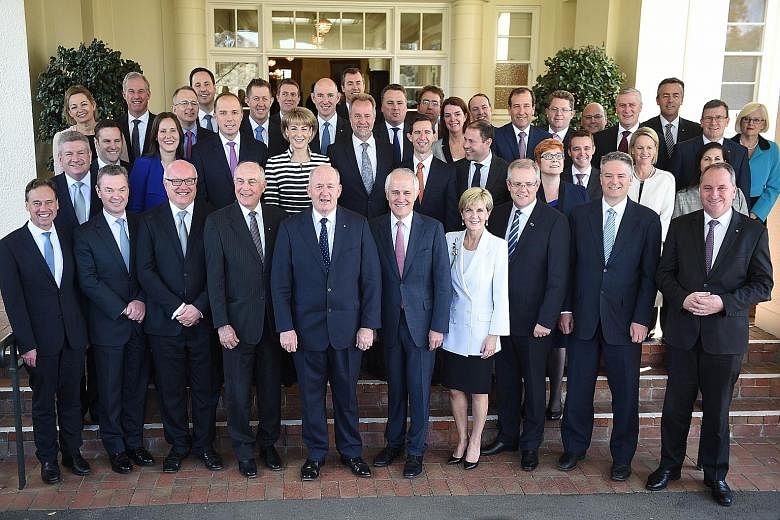At the swearing-in of his first Cabinet in Canberra yesterday, Prime Minister Malcolm Turnbull wore a wider-than-usual grin as he posed for a photograph alongside the women in the line-up.
Such a photograph would have been all but impossible under former Australian leader Tony Abbott, who was ousted by Mr Turnbull in a sudden coup last week. Mr Abbott, a staunch conservative, was widely criticised for including just one woman in his first Cabinet in 2013.
Mr Turnbull has faced no such criticism. His Cabinet has five women, including Ms Marise Payne, the first woman to be Australian defence minister.
But the differences between the two leaders do not end there.
Analysts say the unveiling of the new Cabinet marks a dramatic shift of direction, with the Prime Minister signalling a focus on innovation and reviving the nation's flailing economy.
Described by Mr Turnbull as a "ministry for the future", the Cabinet includes numerous fresh faces and a new minister responsible for cities, Mr Jamie Briggs.
Political commentator Laura Tingle said the promotion of younger, talented MPs and the focus on innovation and urban renewal were aimed at "stealing the future from Labor (the opposition)". "The sheer scale of Turnbull's renovations is breathtaking," she wrote in The Australian Financial Review.
Notably, the new Cabinet excluded several members of the "old guard" of veteran ministers who were loyal to Mr Abbott, such as former defence minister Kevin Andrews.
An expert on Australian politics, Associate Professor Sarah Maddison from Melbourne University, said Mr Turnbull's Cabinet was more progressive than Mr Abbott's team but was also aimed at cementing his leadership.
She said that Mr Turnbull had shrewdly kept some backers of Mr Abbott in senior roles and that he needed to win an election before he could "become the reforming prime minister he has always dreamed of being". "He will have to move very carefully," she told The Straits Times.
"Clearly there is a significant faction in the Liberal Party (that is) not happy that he is in the role. I think we will see a lot of relationship building in the next year without too many significant policy announcements."
Mr Turnbull yesterday insisted the ministers were appointed on merit and he had not sought to demote MPs who backed Mr Abbott during a leadership contest.
"There are people who have been appointed to Cabinet… who were quite open about voting for Tony Abbott in the leadership ballot last week," Mr Turnbull said.
"There was a difference of opinion… but nonetheless there are very prominent people with great ability who have been appointed on merit."
The new Cabinet has been largely welcomed by commentators, but poses several risks.
First, Mr Turnbull has promoted several MPs who are relatively inexperienced and untested. He has tried to offset this gamble by appointing veteran operative Arthur Sinodinos - a long-serving chief of staff to former prime minister John Howard - to the post of Cabinet Secretary.
But a larger risk facing Mr Turnbull, who is seen as more progressive than many MPs in his party on such issues as climate change and marriage equality, is that his Cabinet will alienate the more conservative wing of the Liberals.
Analysts said the widely expected installation of Mr Scott Morrison as Treasurer - a tough but able performer - would help to solidify Mr Turnbull's support among the party's conservative MPs. But the appointment also signalled a willingness to embark on economic reform, particularly an overhaul of the tax system.
Mr Morrison replaces Mr Joe Hockey, a supporter of Mr Abbott, who is quitting Parliament and is reportedly set to be made an ambassador, possibly in Washington.
Political commentator Paul Kelly said that Mr Turnbull's Cabinet was motivated by "generational change, merit mostly, the elevation of women and rewarding of supporters".
"There has never been anything like this in our politics - a sweeping reconstruction and renewal of a first-term government," he wrote in The Australian.
"Turnbull has been decisive, ruthless and clever… He has taken a risk on internal unity but has probably done enough to achieve tolerable cohesion."
While some older backers of Mr Abbott lost their jobs, several younger loyalists of Mr Abbott were retained or promoted. Notably, these included Immigration Minister Peter Dutton and Mr Josh Frydenberg, a rising talent who was made Minister for Resources, Energy and Northern Australia.
Immediately after ousting Mr Abbott on Monday night last week, Mr Turnbull declared that he wants to run a consultative Cabinet-led government.
He now has his team together - including a fresh set of faces that signals a generational change - and so the unveiling of policy can begin.

